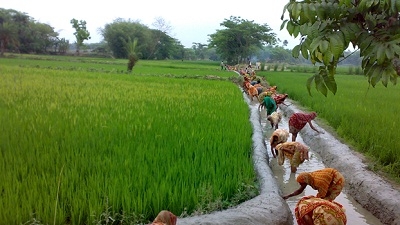Challenge
Persistent seasonal shocks are widely prevalent in rural Bangladesh that results in seasonal poverty and hunger. This is often intensified by crop failure, poor harvest and extreme weather conditions. Many of the poor migrate to cope while others resort to borrowing at high interest or seek support from various public safety net programs.
Reaching these people, the 'most vulnerable' in society, has always been the greatest challenge for the government of Bangladesh. The lack of effective targeting of government resources, transparency and accountability within the safety net system as well as reliable monitoring to ensure results are being achieved are key challenges. The sheer scale of poverty in Bangladesh and the limited fiscal space mean that the government of Bangladesh is constantly looking for better ways to provide social protection for the poor. The Employment Generation Program for the Poorest (EGPP), the country’s first cash based workfare program, is a case in point.
Solution
The EGPP targets the most vulnerable in society in a number of ways. First, a greater proportion of funds are channeled to the poorest Upazilas (sub-districts). Second, only households with less than half an acre of land and where the household head is a manual laborer are eligible. Third, wages are set at below market wage level to attract only those who need the money the most. Furthermore, one-third of all beneficiaries include women. This gender quota increases the probability of particularly female-headed households who are particularly vulnerable, to benefit from EGPP. Male and female beneficiaries receive the same amount of daily wages, making the program particularly attractive for poor women. The EGPP is a new generation of safety net programs that places extra emphasis on improving transparency and monitoring. Wages are paid through EGPP beneficiary bank accounts, which has shown to have significantly reduced leakage. Furthermore, improved public disclosure as well as a new grievance redress system contributes towards better governance.
The World Bank has been supporting EGPP through a results-based loan whereby funds are released upon achievement of results in the areas of improved targeting, better monitoring and evaluation and increased use of better governance measures. This approach creates incentives for efficiency and allows for innovation, making the EGPP the dynamic program it is today. Since 2010, the EGPP has provided over 105 million employment days and distributed a total of $207 million in wage income. With only five years in operation, the EGPP has become one of the largest safety net programs in Bangladesh and received the highest increase in government budget allocation in the FY2012-13.
Results
Since the project began at the end of 2010:
- 630,000 ultra-poor are now employed every year, of which over 200,000 are female
- 95 percent of sub-projects help to build and repair rural roads
- 50 million work days have been created per year
- 100 percent of payments are made via beneficiary bank accounts
- $150 million has been allocated by the government in FY2013, up by $25 million from the previous year.


